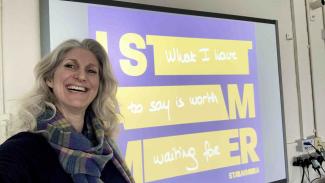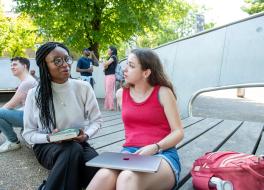Let's Get Talking About Stammering Campaign

A new campaign from STAMMA Educators to raise stammering awareness in schools.
Stammering is rarely spoken about within schools, yet over 8% of children have a stammer and at least 2% go on to stammer as adults.
STAMMA Educators, the network for teachers who stammer, are launching a new campaign to encourage people to go into their local primary or secondary school and speak to young people about stammering.
The campaign was inspired by art teacher and network member Roberta Volpe (pictured above). Wanting to raise stammering awareness in her school but not being able to get it into assemblies, Roberta was given permission to go into every class to talk to children about her experiences. She has been doing this over the last few months and in her article below she tells us all about it (scroll down to read it).
Hold your own talk
STAMMA Educators says, "Please help to get schools talking about stammering by taking part in our campaign or spread the word to encourage others! We have created some resources you can use to make this as simple as possible for you". Follow the steps below.
Step 1: Contact your local school about holding a talk. Download the template email below as a guide.
Step 2: Download the Stammering Talk template pdf below to get an idea of what to include in your talk. If you would like it on PowerPoint, email stammaeducators@gmail.com and they'll send it to you.
Step 3: Take a photo and let STAMMA Educators know how it went. Email them at stammaeducators@gmail.com. Or you can tag them in on socials! Find them on Facebook, Instagram and Twitter using @stammaeducators.
When you go into schools and hold your talk, make sure that a teacher is present in the classroom at all times. You might want to check in with the schools whether DBS checks are required.
Roberta's talk
My name is Roberta Volpe, and I am a secondary school Art teacher. During my PGCE year I asked myself "Can I be a teacher with my stammering?". The question echoed loud in my head. Communication is vital in education, so could I ever be a good teacher if I stammer?
During my placement, thanks to the advice of a great speech & language therapist, I had a chance to face the dragon. I decided to be open about my stammer and tell the class, addressing the 'elephant in the room' myself. This helped to give less power to my fear. But still, during my first year teaching, the feeling of being inadequate remained strong and reflected in my students' behaviour. I was often mocked and laughed at, especially when I had to cover another lesson where the students didn't know me.
When I returned home after another hard day, I thought how unfair it was to be treated like that. If only students could understand the frustration that people who stammer feel — unable to say what they want, when they want; the fear of not knowing when it could happen; of not being in control; and how hard it is to speak with someone who laughs in your face. If I could explain and provide them with the tools to support people who stammer by showing empathy, keeping eye contact and not finishing their sentences. It would be amazing to have a society that's aware of what stammering is.
Immediately something struck me: I am a teacher, and my job goes beyond my teaching subject to educating people! I have the tools to create a better society. I can do this by starting to inform my students, who will be the core of the future society, about what stammering is! I have the power in my hand, I thought. Finally, I could see it!
At the same time I felt overwhelmed at the thought of facing my fears and being so open about my stammer. But I didn't listen to that voice. Buddhism helps to give me the courage to challenge my stammer (I became a Buddhist at 20), and I remember the key to every challenge in my life: take a decision first and then find a way!
Preparation
The first step was to create a presentation. After receiving feedback and strong encouragement from STAMMA, I contacted my school with my proposal last March. My idea was to speak during the weekly assembly. Unfortunately, although they thought it was a good idea, there wasn't any space left until the end of the year.
Last September I proposed my idea again but received the same answer: there was no room in assemblies. At this point, my determination to speak up about stammering became stronger than my fear as I realised how important it was to raise awareness.
I was given two options: I could record a video that would be projected during tutor time, or I could speak in-person to each tutor group. I decided to choose the latter — I wanted to look the students in the eyes and have a dialogue.
My first talk
At the end of November 2022, I started to talk with my first year 7 class. I remember the fear: my throat was dry and my heart was beating so fast when the tutor introduced me. What always gets me through these moments is to think back to when I was at school and bullied because of my stammer. What impact would it have had on my life to hear a teacher talking about her experience? Enormous.
So that's what I did. I talked with years 7 and 8, to more than 500 students. I will meet year 9 and year 10 students next. In each class, I found students listened to me and were engaged. In their eyes, I can often read the surprise of seeing a teacher that so openly said: I am not perfect! Only a couple of times one of the students laughed at my stammer, and I immediately addressed them by saying, "Would you laugh at someone in a wheelchair? Would you? No, so you shouldn't laugh at someone who stammers". I finish my presentation every time with this sentence which I find very powerful: "Remember, we laugh with a person, never at a person. Otherwise, it's not funny; it's bullying."
There have been students who proudly put their hand up after I introduced the topic and said they stammer too. This moment for me is very emotional as I can see in their eyes the happiness of being deeply understood.
Planting seeds
Teaching is a job about planting seeds. Of course, we can't see their total growth, but I know that if even one student one day will give time to someone to finish a sentence, look them in the eyes and show empathy, the worried and sick feeling I had before going into a new class every time will not be wasted.
I felt so flattered when STAMMA Educators, which I am part of, asked me to share my presentation and to be a role model for their campaign; I believe it is important to be open regarding stammering. The more I talk about it, the more I realise that there are people who will always laugh at anything really, but others who don't know that stammering is an 'invisible disability' are willing to learn how to support us.
It is up to us to create a wave of awareness, starting exactly where we are.
Read another of Roberta's articles 'Facing the dragon'

































